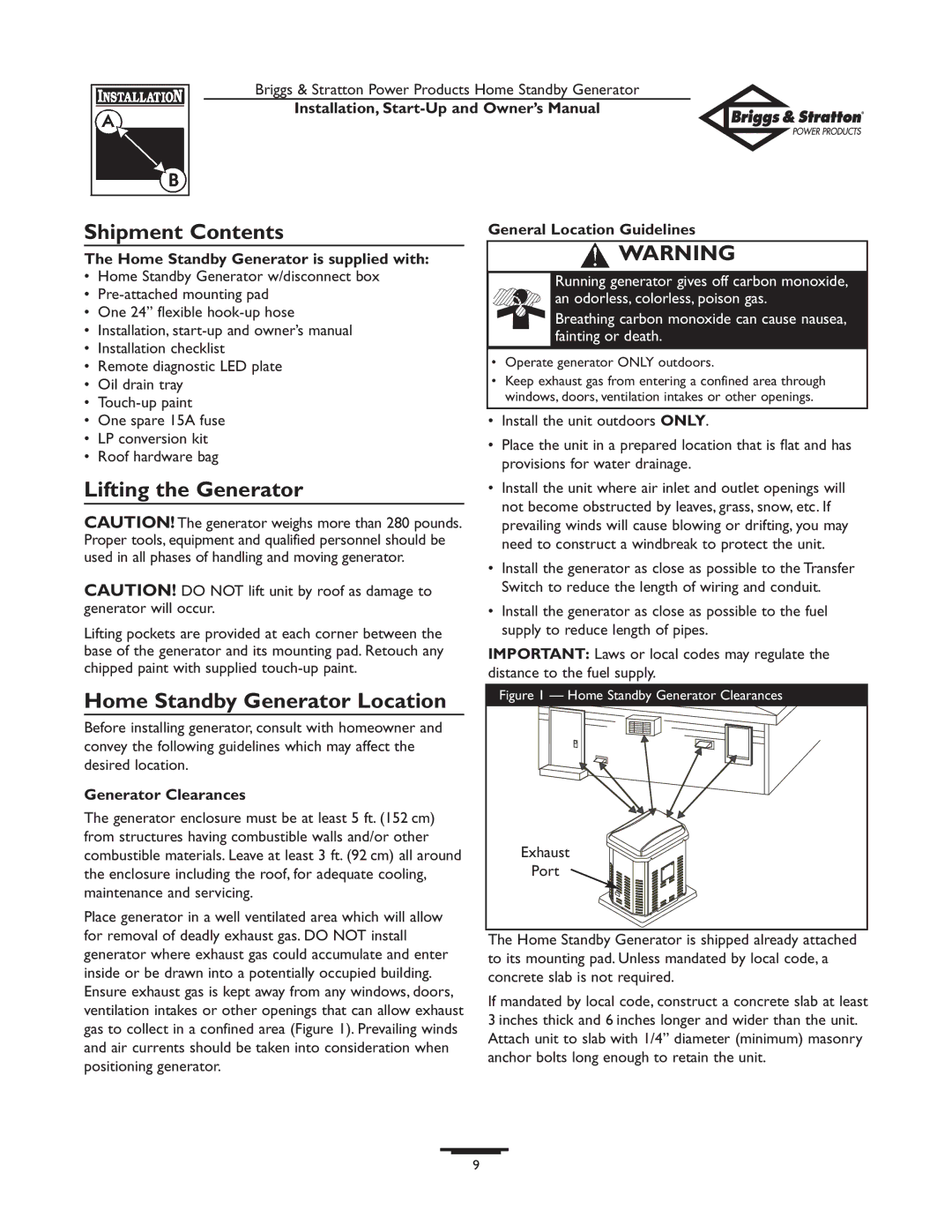
Briggs & Stratton Power Products Home Standby Generator
Installation,
Shipment Contents
The Home Standby Generator is supplied with:
•Home Standby Generator w/disconnect box
•
•One 24” flexible
•Installation,
•Installation checklist
•Remote diagnostic LED plate
•Oil drain tray
•
•One spare 15A fuse
•LP conversion kit
•Roof hardware bag
Lifting the Generator
CAUTION! The generator weighs more than 280 pounds. Proper tools, equipment and qualified personnel should be used in all phases of handling and moving generator.
CAUTION! DO NOT lift unit by roof as damage to generator will occur.
Lifting pockets are provided at each corner between the base of the generator and its mounting pad. Retouch any chipped paint with supplied
Home Standby Generator Location
Before installing generator, consult with homeowner and convey the following guidelines which may affect the desired location.
Generator Clearances
The generator enclosure must be at least 5 ft. (152 cm) from structures having combustible walls and/or other combustible materials. Leave at least 3 ft. (92 cm) all around the enclosure including the roof, for adequate cooling, maintenance and servicing.
Place generator in a well ventilated area which will allow for removal of deadly exhaust gas. DO NOT install generator where exhaust gas could accumulate and enter inside or be drawn into a potentially occupied building. Ensure exhaust gas is kept away from any windows, doors, ventilation intakes or other openings that can allow exhaust gas to collect in a confined area (Figure 1). Prevailing winds and air currents should be taken into consideration when positioning generator.
General Location Guidelines
![]() WARNING
WARNING
Running generator gives off carbon monoxide, an odorless, colorless, poison gas.
Breathing carbon monoxide can cause nausea, fainting or death.
•Operate generator ONLY outdoors.
•Keep exhaust gas from entering a confined area through windows, doors, ventilation intakes or other openings.
•Install the unit outdoors ONLY.
•Place the unit in a prepared location that is flat and has provisions for water drainage.
•Install the unit where air inlet and outlet openings will not become obstructed by leaves, grass, snow, etc. If prevailing winds will cause blowing or drifting, you may need to construct a windbreak to protect the unit.
•Install the generator as close as possible to the Transfer Switch to reduce the length of wiring and conduit.
•Install the generator as close as possible to the fuel supply to reduce length of pipes.
IMPORTANT: Laws or local codes may regulate the distance to the fuel supply.
Figure 1 — Home Standby Generator Clearances
Exhaust
Port
The Home Standby Generator is shipped already attached to its mounting pad. Unless mandated by local code, a concrete slab is not required.
If mandated by local code, construct a concrete slab at least 3 inches thick and 6 inches longer and wider than the unit. Attach unit to slab with 1/4” diameter (minimum) masonry anchor bolts long enough to retain the unit.
9
